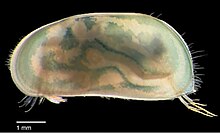Cyprididae

| Cyprididae | |
|---|---|
 | |
| Chlamydotheca unispinosa | |
| Scientific classification | |
| Domain: | Eukaryota |
| Kingdom: | Animalia |
| Phylum: | Arthropoda |
| Class: | Ostracoda |
| Order: | Podocopida |
| Superfamily: | Cypridoidea |
| Family: | Cyprididae Baird, 1845[1] |
| Subfamilies | |
| Synonyms | |
| |
Cyprididae is "the most diverse group of freshwater ostracods".[2] It contains over 1000 species, which represents 50% of the known species of freshwater ostracods (other speciose families include Candonidae, with 25%, and Limnocytheridae, with 10%).[3] Around 60% of genera in the family are endemic to a single zoogeographic region.[3] The family contains 16 subfamilies, and is most diverse in the Afrotropical realm, with over 300 species in 45 genera.[3] Many Cyprididae occur in temporary water bodies and have drought-resistant eggs, mixed/parthenogenetic reproduction and ability to swim. These biological attributes pre-adapt them to form successful radiations in these habitats.[4] Bennelongia is an interesting of the family Cyprididae. It may be the last true descendant of the Mesozoic (and now extinct) lineage of Cypridea, which was a dominant lineage of ostracod in non-marine waters in the Cretaceous.[3]
Taxonomy
[edit]The following genera are recognised in the family Cyprididae:[5]
- Afrocypris Sars, 1924
- Arctocypris Petkovski, Scharf & Keyser, 2016
- Ampullacypris de Deckker, 1981
- Bennelongia De Deckker & McKenzie, 1981
- Bradleystrandesia Broodbakker, 1983
- Bradleytriebella Savatenalinton & Martens, 2009
- Brasacypris Krömmelbein, 1965 †
- Candocypria Furtos, 1933
- Candonocypris Sars, 1894
- Chlamydotheca Saussure, 1858
- Cypretta Vávra, 1895
- Cypria
- Cypridopsis Brady, 1867
- Cyprinotus Brady, 1886
- Cypris Müller, O. F., 1776
- Cypricercus G.O. Sars, 1895
- Diacypris Herbst, 1961
- Dolerocypris Kaufmann, 1900
- Eucypris
- Herpetocypris
- Heterocypris Claus, 1892
- Hungarocypris Vavra, 1906
- Ilyocypris Brady & Norman, 1889
- Kroemmelbeincypris Poropat & Colin, 2012 †
- Kunluniacypris Kempf, 2015
- Martenscypridopsis Karanovic, 2000
- Microcypris Kaufmann, 1900
- Mishinaella Kempf, 2017 †
- Mongolianella Mandelstam, 1956 †
- Neocypridopsis Klie, 1940
- Ngarawa de Deckker, 1979
- Pattersoncypris Bate, 1972 †
- Potamocypris Brady, 1870
- Pseudocypridopsis Karanovic, 1999
- Pseudoeucypris Schneider, 1957
- Reticypris McKenzie, 1978
- Riocypris Klie, 1935[6]
- Sarscypridopsis McKenzie, 1977
- Strandesia Stuhlmann, 1888
- Tanycypris Triebel, 1959
- Tucanocypris Krömmelbein, 1965 †
- Zonocypretta De Deckker, 1981
- Zonocypris Müller, G. W., 1898
References
[edit]- ^ Baird, W. 1845: Arrangement of the British Entomostraca, with a List of Species, particularly noticing those which have as yet been discovered within the bounds of the Club. History of the Berwickshire Naturalists' Club, 2 (13) 145-158
- ^ Robin J. Smith; Horst Janz; Ichiro Okubo (2011). "Recent Cyprididae and Ilyocyprididae (Crustacea: Ostracoda) from Lake Biwa, Japan, including a summary of the lake's ostracod fauna" (PDF excerpt). Zootaxa. 2874: 1–37.
- ^ a b c d Koen Martens; Isa Schön; Claude Meisch; David J. Horne (2008). "Global diversity of ostracods (Ostracoda, Crustacea) in freshwater". In Estelle V. Balian; Christian Lévêque; Hendrik Segers; Koen Martens (eds.). Freshwater Animal Diversity Assessment. Developments in Hydrobiology. Springer. doi:10.1007/s10750-007-9245-4. ISBN 978-1-4020-8258-0.
- ^ D. J. Horne; K. Martens (1998). "An assessment of the importance of resting eggs for the evolutionary success of non-marine Ostracoda (Crustacea)". In Luc Brendonck; Luc de Meester; Nelson Hairston (eds.). Evolutionary and ecological aspects of crustacean diapause. Advances in Limnology. Vol. 52. E. Schweizerbart. pp. 549–561. ISBN 978-3-510-47054-9.
- ^ "WoRMS - World Register of Marine Species - Cyprididae Baird, 1845". www.marinespecies.org. Retrieved 2022-12-13.
- ^ Riocypris Klie, 1935
External links
[edit] Data related to Cyprididae at Wikispecies
Data related to Cyprididae at Wikispecies